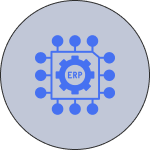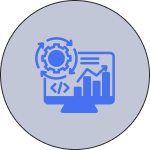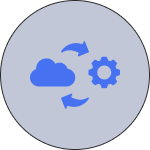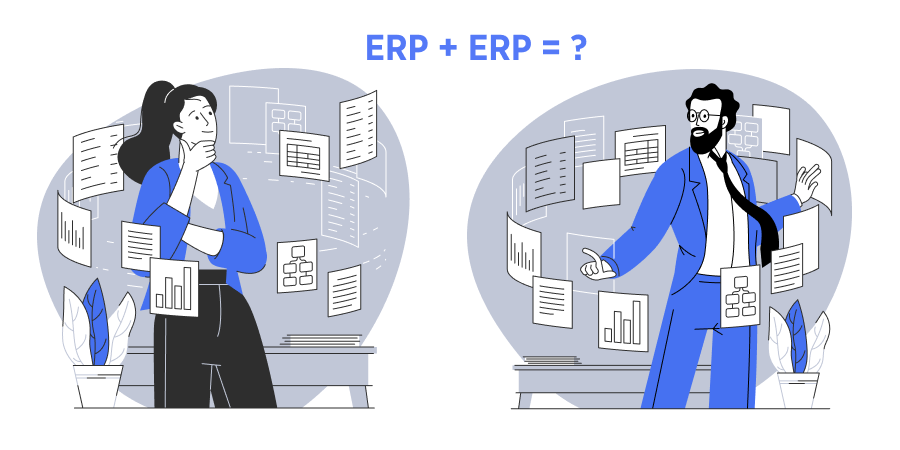Managing a large-scale organization is like operating a complex machine — every part must work together seamlessly to achieve a successful outcome. But making this happen is no walk in the park. There are countless elements that require attention, often spread across multiple levels, making the challenge even more intricate and multifaceted.
This complexity underscores the need for efficient workflow orchestration. Relying on manual processes is simply impractical given the sheer volume of simultaneous activities. Plus, such an approach undermines transparency and compromises the quality of execution.
To stay competitive, businesses can’t afford to jeopardize their reputation. They aim to maintain the highest service standards, but this goal is increasingly difficult to achieve without dedicated software.
In this article, we’ll speak about ERP as a class of systems that today’s businesses can’t do without. Why is it an indispensable element for large-scale organizations? What types of ERP software are out there? And most importantly, how do you choose the right one for your unique needs? Keep reading to find out!
The Essence of ERP and What Stands Behind the Acronym

In a broad sense, ERP or Enterprise Resource Planning software is a kind of system intended for digitalization and automation of a wide set of aspects within a company. And in the modern world, such systems may encompass literally everything.
However, if we consider an ERP in a narrower sense, these systems were initially intended for manufacturing companies looking to qualitatively automate the most critical processes. These include such components as supply chain, inventory, and sales management.
To have a better understanding of why exactly for such kinds of businesses ERPs are mission-critical, let’s review an example of a plant, say, producing aircraft engines. Sure thing, they have a supply chain of components needed for manufacturing, record of labor resources, and, of course, equipment.
Say, they have a robot building these engines on a production line. And just imagine what happens if this piece of equipment suddenly breaks down paralyzing the entire manufacturing process. This incident automatically entails serious downtimes and therefore, direct losses. Agree, for plants and factories, there’s almost nothing more terrifying than the interruption of a manufacturing process, even a minor one.
Learn about Enterprise Manufacturing Intelligence
And here’s why ERP is essential for such organizations — it helps not only manage the inventory and control the supply chain process but also assists with predictive service management. With this kind of software, companies can monitor equipment conditions and take predictive measures, say, launch an extra production line and send the robot for maintenance before it errors out and becomes the reason for downtime.
Sure thing, not only companies from the manufacturing domain manage their processes through ERP systems. Many other types of organizations have similar workflows and are in need of adequate resource planning and distribution.
There is an abundance of various systems on the market. Why are they needed and why not use only one unified software covering basic needs, you may ask? Indeed, if we consider the situation on a high level, companies’ business processes are quite similar and in theory can be covered by versatile ERP software. However, it’s not always like that.
Even though seemingly similar organizations can operate in the same industry and provide similar services, their business processes may differ dramatically. Here’s why the existence of a huge number of available ERPs for any taste is truly justified. Since each and every company may select the one that ideally fits their unique needs. Let’s speak about software types in the following section.
Sorting Out Types of ERP Systems
Now that we’ve explored why such platforms are essential and which businesses rely on them to keep workflows running smoothly, it’s time to dive into the classification of ERP systems available. Below, we’ll break down the major types of ERP software and what sets them apart.
Binding to an Industry
Versatile ERP Systems

Let’s start with the biggest class of platforms — these are common comprehensive ERP systems without regard for the concrete industry. As we mentioned, not only large-scale manufacturing companies need automation and effective resource planning, but also businesses operating within less complex and intricate domains.
As a rule, such software contains modules supporting major business aspects, without any specifics. It serves as a constructor, and on its basis, you are empowered to build almost anything you need (within the selected platform’s capabilities, of course).
Is it possible to use a versatile ERP system as a foundation to create something highly specialized? Of course, but it must be highly flexible so you can rebuild and grow it for yourself. Vivid examples here are such advanced platforms as SAP or Oracle ERPs that can be tailored to almost any business needs.
There is a caveat, though. Let’s imagine that a car manufacturer needs an ERP platform and turns to the companies mentioned above to get one. With a high probability, they would have an out-of-the-box solution specifically aimed at the automotive industry that can be integrated with their standard resource planning platform.
This way is quite standard, yet quite expensive. And it’s logical — if you want something fast, be ready to pay for that. Sure thing, you can also take a longer path and hire a software development vendor to develop a brand-new custom solution. And here’s up to you to decide, which option suits you more. In the following section, let’s take a closer look at industry-specific platforms and their implementation intricacies.
Industry-Specific ERP Software

This category of ERP systems is initially designed specifically for the unique needs of a particular industry. Take again the automotive sector, for example. There are ERP solutions built with preconfigured features tailored to this field, including specialized reporting and openness to integrations.
Why does this matter? For several key reasons, including:
- Strict regulations – Many industries, including automotive, must comply with rigorous standards.
- High expectations – Production quality and reliability are critical, leaving no room for errors.
- Business domain complexity – A bunch of intricacies inherent to this or that manufacturing process.
As for domain complexity, let’s review this aspect in more detail. Have you ever thought about how many details a modern car consists of? Approximately 20,000 parts are carefully designed, manufactured, and assembled to create a single vehicle.
Each of these components comes from various suppliers, follows strict quality standards, and must seamlessly integrate into the final product. Managing this intricate web of parts, processes, and logistics is impossible without a robust ERP system tailored to the automotive industry’s needs.
Check out how we helped a car dealer with Sales Process Automation
Another characteristic inherent to industry-specific ERPs is ultimate openness to integrations. In general, software introduced into the business processes of such organizations can’t exist autonomously — it always functions in conjunction with other systems (accounting, CRMs, and others).
All because even the most modern and comprehensive ERP system can’t encompass 100% of operations flowing within a large-scale organization with a complex business domain. Not to sound unfounded, let’s also take the banking sphere as an example.
Say, there is a trusted transnational bank with a long history, providing all kinds of financial services to businesses and individuals. How do you think, is there even a minor chance to do with only one single system to orchestrate all the processes within the financial organization? Extremely unlikely.
As a rule, the number of solutions introduced in the banking ecosystem can amount to hundreds or even thousands. This especially applies to traditional organizations, established decades ago. Such a business ecosystem is extremely complex: different branches may use different platforms, including legacy ones.
From this follows a conclusion that the more complex and traditional the organization is, the more intricate its ecosystem will be. All because of the abundance of standalone legacy apps they use for various purposes that can’t be easily abandoned. Therefore, even an ERP system in use, seemingly a comprehensive one, might be insufficient to cover all the aspects within the company.
Find out when It’s Time to Move On From Your Legacy Enterprise Software
Another matter is a conditional neobank established relatively recently. Such market players are unburdened by numerous legacy systems and are free to introduce brand-new unified ERP software for business process automation. However, it’s important to keep in mind that it’s also a matter of time.
Decades later, these companies will inevitably experience the same challenges. That’s why it’s better to keep these perspectives in mind and introduce a system that is not only effective for current operations but also scalable and adaptable for future growth. By implementing a flexible ERP solution from the start, neobanks can prevent the accumulation of disparate systems and avoid or at least mitigate the pitfalls traditional banks face today.
Deployment Model
On-Premises ERP

ERP systems have come a long way. It all started with client-server solutions, where users connected via local networks to carry out operations. Then came massive mainframes — so large they occupied entire buildings — powering enterprise-wide ERP deployments. Today, as businesses become increasingly global, they set up local networks to stay connected and keep operations running smoothly.
These are all examples of on-premises deployment — a model that many companies are reluctant to abandon. And for good reason. As we explore other deployment options, it’ll become clear why some organizations still stick with local servers.
Cloud-Based ERPs

Along with the Internet evolution and its speed and reliability improvement, many businesses decide in favor of the cloud model. This means that their ERP platform isn’t deployed on local servers but is hosted on remote data centers, accessible from anywhere with an Internet connection.
This brings us to one of the biggest reasons why many organizations — especially those in sensitive industries — are hesitant to fully embrace the cloud.
Not every location has fast, reliable, or affordable Internet. In some areas, connectivity issues are still a major hurdle. But even in well-connected regions, no one can predict a sudden outage or force majeure event that cuts off access entirely. If your critical operations depend on the Internet, a disruption could bring everything to a standstill — a risk many businesses simply can’t afford to take.
Read about Cloud Disaster Recovery and How to Restore Access to Data and Critical Infrastructure
Hybrid ERP

If you want to leverage the benefits of a cloud-based ERP solution but can’t afford even the slightest risk of downtime due to internet issues, the hybrid model is your ideal solution. Especially if your ERP system is involved in the manufacturing process and production line functioning directly depends on the system’s reliability.
Why so? Because it allows you to parallelize your workflows. Your most critical operations can run on local servers, ensuring uninterrupted performance, while non-essential processes can be handled in the cloud. This way, you get the best of both worlds — the reliability of on-premises infrastructure and the scalability of cloud computing.
Combining ERPs Within One Organization. Why the Approach Is Reasonable

Many businesses dream of having a single, all-encompassing system to manage their workflows. And it’s easy to see why — constantly switching between platforms is inefficient and frustrating. However, in reality, a hybrid approach when a company uses various ERP systems is often the best solution.
Why? Because even the most comprehensive ERPs can become overly complex and difficult to adapt over time.
Take this scenario: A newly established bank, free from legacy systems, successfully operates with a single ERP for years. Then, out of the blue, the Central Bank rolls out a new regulation that must be implemented immediately. With no time to modify their existing system, the bank opts for a third-party solution, integrating it with their ERP to stay compliant.
Voila, their once-unified system now consists of two platforms. And who’s to say more changes won’t come in the future and the need to adopt additional tools won’t occur? By the way, it’s also one more pro of thinking about the integration capabilities of different types of ERP systems before their adoption to remain flexible.
Summing Up
With countless ERP solutions available, choosing the right one for your business can feel overwhelming. The best fit depends not just on your company’s unique needs but also on how flexible and scalable the system is for future growth.
Even if you find the perfect one among different types of ERP systems, that checks all the boxes, you’ll also need a reliable vendor able to smoothly integrate the new platform into your ecosystem. At Velvetech, we’ve successfully delivered numerous ERP development projects, ensuring smooth implementation and optimization for businesses like yours. Ready to streamline your operations? Reach out to us, let’s make it happen together!









